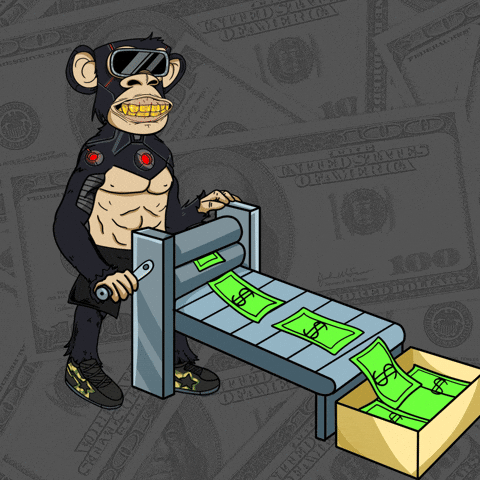- Chasing Money
- Posts
- When the Market Hangover Hits: Tech Sinks, Gold Glows
When the Market Hangover Hits: Tech Sinks, Gold Glows
February 25, 2025, started like any other day on Wall Street.
Traders sipped their morning coffee while keeping an eye on the markets.

Gif by Grittv on Giphy
The atmosphere was calm, even routine.
But by midday, that calm shattered.
The S&P 500 slid 0.5%, marking its fourth consecutive loss.
The Nasdaq tumbled 1.35%, weighed down by heavy tech selling.
One of the biggest shockwaves came from Palantir, which has been in freefall plunging 25% over the past week to close at $13.45 per share, its lowest price since 2023.
Even Bitcoin, the digital darling of modern investors, wasn’t spared.
It dropped to $87,000, down 12% from its recent peak.
Meanwhile, gold, a classic safe haven surged to $3,000 an ounce, a record high.
The post-election euphoria that had fueled the markets since November? Gone. In its place, a creeping sense of fear is taking over.
The Party’s Over
Just three months ago, the mood couldn’t have been more different.
Markets were on fire, riding a wave of optimism fueled by Donald Trump’s return to the White House.
Investors celebrated his promised tax cuts, deregulation, and a pro-business agenda.
The S&P 500 soared 15% between November and January, driven largely by tech giants like Nvidia and Palantir.
AI was the golden goose.
Nvidia’s cutting-edge chips powered a revolution in artificial intelligence, while Palantir’s government-backed data analytics made it a market darling.
Investors were convinced that these companies would lead the next decade of growth.
But by February, cracks in that rosy narrative began to show.
Three major concerns spooked the market:
Rising Tariffs: The Trump administration’s aggressive new tariffs on Chinese goods threatened to drive up prices and choke global trade.
Federal Job Cuts: With a promise to slash government spending, job cuts loomed across multiple agencies.
Stagflation Fears: A toxic mix of rising prices and slowing growth began to haunt economists and investors alike.
The bond market delivered the loudest warning.
The yield on the 10-year Treasury fell to 4.31%, the lowest level since December 2024.
Falling yields usually signal easing inflation.

Gif by BoredMemes on Giphy
But this drop hinted at something worse, investors were betting that the economy was slowing down fast.
“Bonds are screaming recession,” warned Chris Rupkey, chief economist at FwdBonds.
Palantir’s Pain Becomes a Warning Sign
Few stocks captured the market’s mood shift better than Palantir.
Just weeks ago, the data analytics firm was seen as a cornerstone of the AI boom.
Over 56% of its revenue came from lucrative government contracts, especially with the Pentagon.
But trouble was brewing.
In early February, the Department of Defense announced it was slashing $2.1 billion from defense tech spending, focusing instead on cheaper alternatives like drone technology.
The impact on Palantir was immediate and brutal.
Its stock fell from $18.00 in mid-February to $13.45, a loss of over 25% in just a week.
CEO Alex Karp tried to calm investors.
Palantir CEO Alex Karp recently appeared for an interview on CNBC, during which he endorsed Elon Musk. He also advocated stifling free speech on college campuses, which he claims is to protect Western values but has admitted in the past that it has more to
— BLM4Corbyn (@BLM4Corbyn)
11:44 AM • Feb 26, 2025
In a statement, he emphasized that Palantir’s AI-driven platforms remained essential to national security.
But Wall Street wasn’t buying it.

Gif by bettercallsaulAMC on Giphy
The market’s verdict was clear: Palantir was no longer untouchable.
And the pain didn’t stop there.
The Roundhill Magnificent Seven ETF, which tracks major tech names like Nvidia, Apple, and Microsoft, fell into correction territory, dropping 10% from its January highs.
Investors were no longer willing to pay premium prices for growth at any cost.
Fear Takes Control
Beneath the falling numbers, fear was spreading like wildfire.
The Cboe Skew Index, which measures demand for protection against extreme market crashes, shot up to 183, its highest level since 2005.
For those of you that follow $SKEW, you know that the index is generally between 100 and 150 (per the CBOE below).
Since 1990, there have only been 14 readings OVER 150.
10 of those 14 have happened in the last 110 calendar days.
cboe.com/products/vix-i…
$SPY $SPX $VIX
— OddStats (@OddStats)
6:00 PM • Nov 5, 2018
For context, anything above 150 suggests investors are bracing for major volatility.
Meanwhile, the VIX often called Wall Street’s “fear gauge” briefly surged past 20, a psychologically important threshold signaling rising anxiety.
Traders were scrambling to hedge against a potential disaster.
Consumers were feeling the squeeze too.
The Conference Board’s Consumer Confidence Index fell 7 points to 98.3, its steepest drop since 2021.
#Consumer#confidence#dropped sharply in February, with the #Conference#Board’s #index falling 7% to 98.3, the lowest since June 2024. It is also the largest monthly decline since August 2021.
dailyshorts.io/economy/inflat…— DailyShorts.io (@DailyShorts3)
12:00 PM • Feb 26, 2025
Families are increasingly worried about higher prices on essentials like groceries and gas, along with the possibility of layoffs.
Yet, in a strange twist, corporate leaders seemed unfazed.
The CEO Confidence Index actually hit a new high in February. “Main Street sees a hurricane.
Wall Street sees a sunshower,” said Callie Cox, investment strategist at Ritholtz Wealth Management.
The Flight to Safety
When fear rises, investors seek shelter, and that’s exactly what happened.

Gif by ufc on Giphy
Defensive sectors like healthcare and utilities became the market’s safe havens.
Both sectors are up nearly 9% this year, easily outperforming the broader market.
Companies like Eli Lilly and Novo Nordisk are thriving, thanks to surging demand for obesity drugs.
Gold’s record-breaking rally to $3,000 an ounce tells its own story.
When uncertainty reigns, gold shines.
Bitcoin, however, is proving to be anything but a safe haven.
Its 12% slide over the past week suggests that investors still see it as a speculative asset rather than a reliable hedge against chaos.
What’s Really Happening?
Defense Cuts Hit Tech Hard:
The Pentagon’s decision to slash $2.1 billion from tech spending is a major blow to companies like Palantir. Meanwhile, newer firms like Anduril are gaining ground by offering cheaper, AI-driven alternatives.Bonds Predict a Slowdown:
The falling 10-year yield is a warning sign. Analysts worry that rising tariffs and labor shortages could trigger stagflation, where rising prices collide with stagnant economic growth.Options Market Bets on Disaster:
Traders are preparing for the worst. Options betting on Palantir falling to $12 by March are trading at 10x their normal volume, signaling fears of a catastrophic sell-off.
What’s Next?
Soft Landing (35% Chance):
If the Federal Reserve cuts interest rates by September, the market could stabilize.
Tech and consumer spending could bounce back, with the S&P 500 potentially hitting new highs.
Stagflation (45% Chance):
If tariffs and labor shortages persist, the economy could slip into stagflation.
Defensive stocks would thrive while gold climbs beyond $3,500 an ounce.
Tech Crash (20% Chance):
If AI valuations collapse, the S&P 500 could plunge another 15-20%.

Gif by snl on Giphy
Palantir could fall below $10, and Bitcoin might test $70,000 as investor confidence crumbles.
The New Rules
The market is shifting.
Defensive sectors like healthcare and utilities are winning.
Gold is the ultimate safe haven, Bitcoin isn’t.
Government-dependent tech firms are vulnerable.
All eyes are now on Nvidia’s earnings report on February 26.
A strong showing could slow the sell-off. A miss? It could pour gasoline on the fire.
The Bottom Line
February 25 wasn’t just another bad day, it was a turning point.
The era of easy money and endless tech growth is over. Markets are moving from wild optimism to cold, hard reality.
As Charlie McElligott from Nomura put it, “Markets hate uncertainty, and that’s all we’ve got.”
In this new world, survival isn’t guaranteed. Adapt or sink.
Love what you're reading?
Chasing.money is a small pub with big ideas. Help us grow! Share our newsletter with those who want the real story.
Reading this in your email? Forward it to your contacts and help us reach more people. Thank you for your support!
Claim Your Free Gold IRA Guide
Claim your free Gold IRA Guide and discover the crucial steps to take when opening your Gold IRA!
Claim Your Free Gold IRA Guide
Claim your free Gold IRA Guide and discover the crucial steps to take when opening your Gold IRA!



